Samsung Announces Galaxy Tab S7 & S7+: S865+ & 120Hz Tablets
by Andrei Frumusanu on August 5, 2020 2:00 PM EST- Posted in
- Mobile
- Samsung
- Tablets
- Galaxy Tab S7
- Galaxy Tab S7+
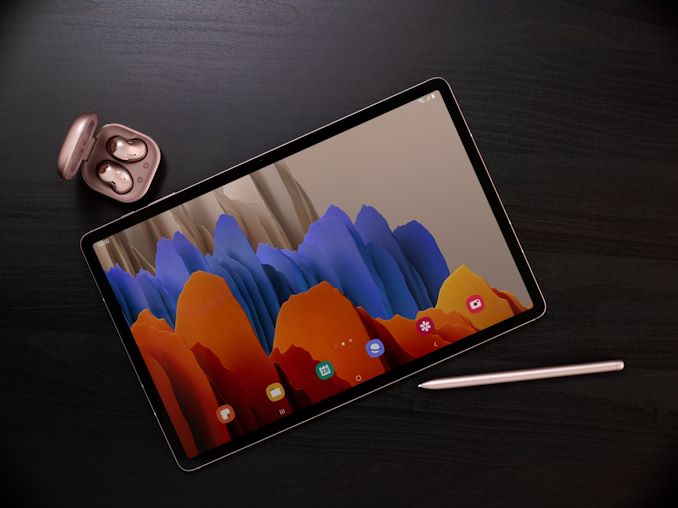
Today alongside the Note20 series smartphones, Samsung is also releasing a pair of new high-end tablets in the form of the new Tab S7 and Tab S7+. It’s been a long time since we’ve seen some good Android tablets as the market is seemingly small and struggling versus the more common-place Appls iPads – but today’s S7 series is really raising the bar in terms of hardware capabilities, bringing some significant updates to the table for what probably are the best Android tablets on the market right now.
What makes the new Galaxy Tab S7 tablets shine is their brand-new Snapdragon 865+ processors alongside high-resolution 120Hz screens, big batteries, quad-speaker setups and a new design that it’s incredibly thin.
| Samsung Tab S7 Series | |||
| Galaxy Tab S7 | Galaxy Tab S7+ | ||
| SoC | Qualcomm Snapdragon 865+ 1x Cortex-A77 @ 3.1GHz 3x Cortex-A77 @ 2.42GHz 4x Cortex-A55 @ 1.80GHz Adreno 640 @ ?MHz |
||
| Display | 11-inch LTPS LCD 2560 x 1600 (16:10) 120Hz |
12.4-inch OLED 2800 x 1752 (16:10) 120Hz |
|
| Dimensions | 253.8 x 163.3 x 6.3mm 498-502g |
285.0 x 185.0 x 5.7mm 575g |
|
| RAM | 6 / 8 GB LPDDR5 | ||
| NAND Storage |
128 / 256GB + microSD |
||
| Battery | 8000mAh (30.96Wh) typ. | 10090mAh (39.04Wh) typ. | |
| 45 Super-fast Charging (18W included charger) |
|||
| Front Camera | 8MP | ||
| Primary Rear Camera | 13MP wide-angle | ||
| Secondary Rear Camera |
5MP ultra-wide-angle | ||
| 4G / 5G Modem |
|||
| Snapdragon 5G - Snapdragon Modem X55 (Discrete) (LTE Category 24/22) DL = 2500 Mbps - 7x20MHz CA, 1024-QAM UL = 316 Mbps 3x20MHz CA, 256-QAM (5G NR Sub-6 + mmWave*) DL = 7000 Mbps UL = 3000 Mbps *Depending on region and model |
|||
| SIM Size | NanoSIM + eSIM | ||
| Wireless | 802.11a/b/g/n/ac/ax 2x2 MU-MIMO, BT 5.0 LE, NFC, GPS/Glonass/Galileo/BDS |
||
| Connectivity | USB Type-C no 3.5mm headset |
||
| Special Features | Side capacitive fingerprint sensor | Under-screen fingerprint sensor | |
| Quad-Speakers with Dolby Atmos | |||
| Launch OS | Android 10 with Samsung OneUI 2.0 | ||
| Launch Prices | 6+128GB (Wi-Fi): $ n/a / 699€ / £619 8+256GB: (Wi-Fi): $ n/a / 779€ / £ n/a 6+128GB (LTE): $ n/a / 799€ / £719 8+256GB: (LTE): $ n/a / 879€ / £ n/a |
6+128GB (Wi-Fi): $ n/a / 899€ / £799 8+256GB: (Wi-Fi): $ n/a / 979€ / £ n/a 6+128GB (5G): $ n/a / 1099€ / £999 8+256GB: (5G): $ n/a / 1179€ / £ n/a |
|
Starting off with the SoC, it features the new high-performance binned Snapdragon 865+ SoC from Qualcomm, with Samsung here using the full 3.1GHz peak frequency on the prime CPU core. It’s a nice performance boost and should make the new Tab S7’s the fastest Android tablets on the market right now.
Samsung is configuring both the Tab S7 and Tab S7+ with either 6GB of LPDDR5 with 128GB of storage, or 8GB of RAM with 256GB. There is a microSD slot for expandable storage.
The star of the show today is the Tab S7+ which features a 12.4” OLED display with a 2800 x 1752 resolution as well as a 120Hz refresh rate that’s enables at the full native resolution of the panel. In essence this checkmarks all the possible features a display can have and should be by far the best tablet experience in the market in this regard.
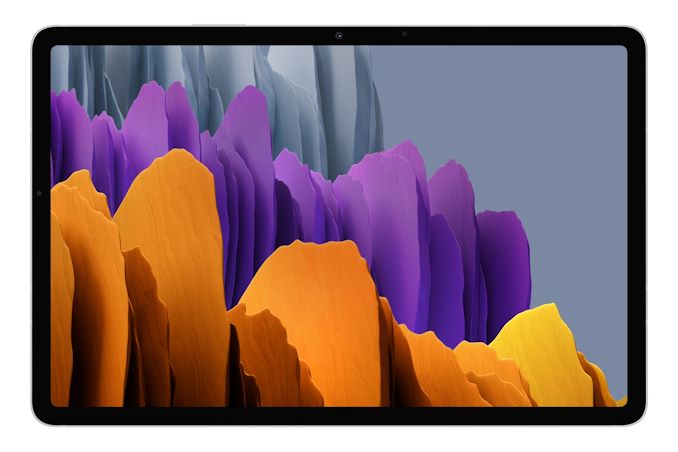 The regular Tab S7 features a similar resolution screen at 2560 x 1600, but at a smaller 11” form-factor and this time around it’s an LCD display. It maintains a 120Hz refresh rate so that will still allow it an extremely smooth content experience.
The regular Tab S7 features a similar resolution screen at 2560 x 1600, but at a smaller 11” form-factor and this time around it’s an LCD display. It maintains a 120Hz refresh rate so that will still allow it an extremely smooth content experience.
The backs of the new tablets are relatively ordinary, except for a prolonged design element that extends from the cameras. This is the charging surface for the new S-Pen which can be held by the accessory Book Cover or Book Cover Keyboard in this position.
The cameras of the tablets are quite nondescript, with Samsung only revealing 8MP for the front camera, a 13MP main camera, and a 5MP ultra-wide angle. We’re not expecting any great quality out of either of these.
Size-wise, as the Tab S7+ is a bigger device, it also has a bigger footprint and weight, about 12% larger in each dimension and a little heavier at 575g. The S7+ features a 10090mAh battery while the S7 features a 8000mAh unit.
Besides the high-quality displays of the new tablets, the one other design element of the new devices is their thickness which comes in at only 6.3mm for the Tab S7 and a mere 5.7mm for the Tab S7+, making the latter the thinnest tablet of this class ever made.
Alongside the side frames we find four speaker grills which house the quad-speaker setup of the tablets, with audio being tuned by AKG and also supporting Dolby Atmos.
The Tab S7 and S7+ will come in either Wi-Fi, LTE (S7 only) and 5G variants (market dependent). Availability of the different models with different configurations as well as RAM and NAND capacity will be highly dependent on local region. In mainland Europe, the Tab S7 starts at 699€ for the Wi-Fi model, and 799€ for the LTE model. The Tab S7+ starts at 899€ for the Wi-Fi variant, and 1099€ for the 5G variant. An upgrade to the 8+256GB variants costs an extra 79€ on top of that.
Availability starts August 24th.


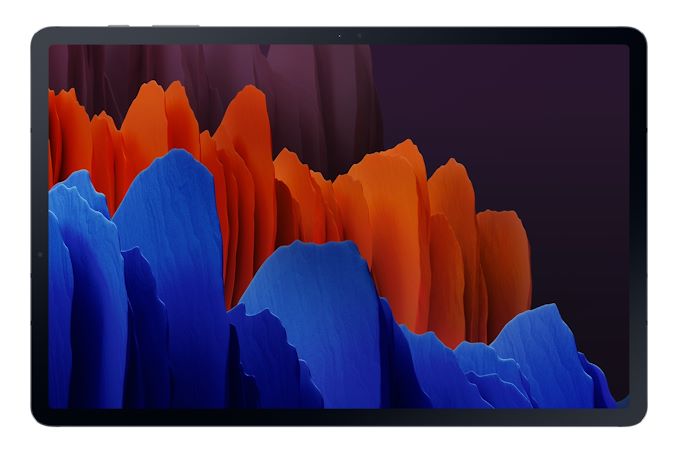
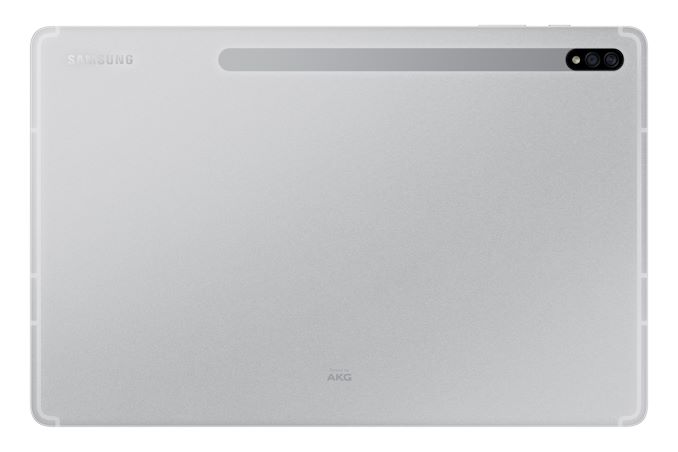
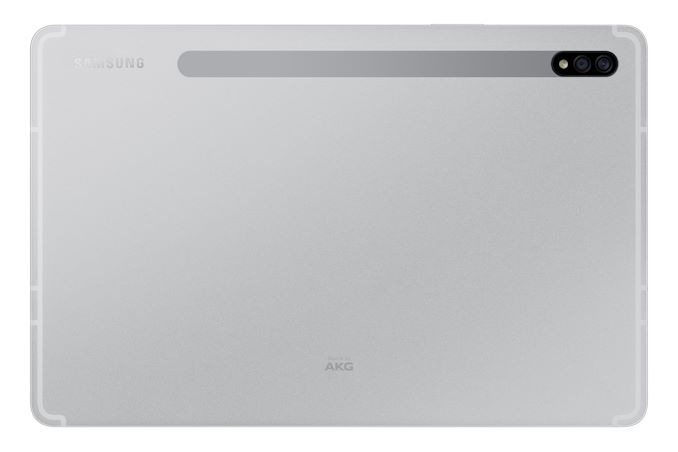










74 Comments
View All Comments
danbob999 - Wednesday, August 5, 2020 - link
Why would a typical tablet user need a 120 Hz display?Most people don't even have 60+ Hz computer monitors. I think it's a gimmick.
cknobman - Wednesday, August 5, 2020 - link
For the pen and responsiveness.danbob999 - Wednesday, August 5, 2020 - link
BS. I bet if there is a way to reduce the refresh rate to 60 Hz you won't notice the difference when using the pen.dotjaz - Wednesday, August 5, 2020 - link
That's a lotta BS from someone who can't even see the benefit of HRF. I can't be bothered looking at anything below 90Hz. It's just too choppy.imaheadcase - Thursday, August 6, 2020 - link
Oh good you are the majority of people..said no one ever.Socius - Wednesday, August 5, 2020 - link
Why would you make such an assinine comment? I have a Galaxy Tab S6, and an iPad Pro 12.9. The 120Hz refresh rate provides such an incredibly smooth interaction when doing even the simplest of things such as scrolling on a website. Also pen polling rate is very important. While my iPad pencil feels almost like you're literally writing on paper in terms of its responsiveness, the writing on the Galaxy Tab S6 is horrendous beyond belief, so much so that I don't even carry the pen with me, even though my case literally has a holder for the pen.Refresh rates are more important than you think. Try them side by side and you won't doubt it.
danbob999 - Thursday, August 6, 2020 - link
what makes you think the difference you notice is because of 120 Hz and not the fact that it's a completely different device with different OS?sneakyB - Thursday, August 6, 2020 - link
Yeah Socius, what makes you think your knowledge is better than his ignorance, mmh ?saratoga4 - Thursday, August 13, 2020 - link
danbob999: Latency for a lot of the rendering and display pipeline is dictated in frames, not milliseconds. So increasing the frame rate from 60 to 120 doesn't reduce latency by half of a 60 Hz frame, but rather by half of a 60 Hz frame times the number of frames of latency built into the display pipeline.This can actually be a fairly large number. A simple experiment you can do is to swipe your finger back and forth on a tablet or phone drawer or other menu and watch how much the UI lags behind where your finger is. Typically it will several frames behind where your finger is.
shabby - Wednesday, August 5, 2020 - link
Umm all monitors have been 60hz for a looooong time.